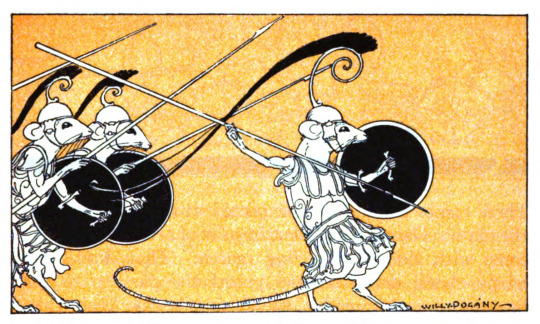#willy pogány
Explore tagged Tumblr posts
Text

Willy Pogány (1882-1955), ''My Poetry Book'', 1948
#Willy Pogány#William Andrew Pogany#hungarian artists#vintage illustration#vintage art#my poetry book#children's books
178 notes
·
View notes
Text

Willy Pogány (1880-1955) Fairy Tale story illustration (undated) Source
35 notes
·
View notes
Text

Archer by Willy Pogány
1 note
·
View note
Text

William Andrew Pogány - “The Tale of Lohengrin, Knight of the Swan” by T.W. Rolleston, 1914.
74 notes
·
View notes
Text

a demon and an angel from Eden - Part I or the first Good Omens fanart I'm actually posting - I found an illustration on pinterest and instantly thought it feels like them, so I drew it!
a demon and an angel from Eden - Part II > look under the cut for the reference I used!

Willy Pogány, 1912, illustration for Parsifal or the Legend of the Holy Grail by T. W. Rolleston
177 notes
·
View notes
Text


from Part II "The Deliverance" ~ from E. W. Rolleston's translation of Wagner's "Tannhäuser" ~ illustrated by Willy Pogány (Hungarian illustrator, 1882-1955)
54 notes
·
View notes
Text

“The Children of Odin” (1920). Illustration by Willy Pogány
57 notes
·
View notes
Text
Circe and the Pigs

The unhappy Greeks turned into Swine (engraving) by English School, (19th century); Private Collection; (add.info.: The unhappy Greeks turned into Swine. Illustration for Chatterbox (1886).
"For, from the inside of the gloomy palace, they heard somebody singing even more sweetly than the sirens sang.
The glorious voice swept up to the roof and out into the courtyard. Peeping through the door, the men saw a lovely maiden with golden hair, and white hands busy with tapestry upon a loom. She looked up from her work and ceased her song as she saw the wondering faces at the entrance. Then, rising to her feet, she went to meet them with an enchanting smile and invited them to come in.
One after another, the crew shyly entered — except Eurylochus. He was suspicious of this beautiful being, and hid himself outside in the courtyard, waiting to see what would happen. The enchantress, whose name was Circe, seemed to be quite alone in the palace. She herself showed her visitors to the fine seats, piled with soft cushions, that were placed all around the hall; and, with her own hands, served them with a feast of delicate white bread, ruby-colored wine, creamy milk, and golden honey. Very hungry and thirsty the men were, and they all ate and drank gladly; but, as time went on, they began, one by one, to nod with drowsiness. Well they might, for Circe had mixed with the wine and the milk magical herbs of which she alone knew the secret. As soon as her guests were half-asleep, she drew out her sorceress’s wand and waved it around and around their nodding heads.
The poor unfortunate sailors, who had been enjoying themselves so thoroughly, felt their noses growing very long, their legs very short, and their bodies very round and coarse. Their hair turned to bristles on their heads, and their ears became like little flaps. Their eyes grew small, round, and cunning; and, when they tried to speak, they could only grunt or squeal! Squealing and grunting, they jumped from their beautiful thrones onto the floor; still squealing and grunting, they ran out of the door as Circe went on waving her wand. She had turned them all into pigs, and, as pigs, she drove them before her into another courtyard behind the palace and locked them up in a big, empty sty. Then, instead of wine and honey, she threw them down a meal of beech nuts and acorns and went disdainfully away."
Full Story here: Circe: The Beautiful Enchantress and the Pigs

Circe And Her Swine, Painted By Briton Rivière (c. 1840-1920)
Circe (/ˈsərsiː/;Ancient Greek: Κίρκη : Kírkē) is an enchantress and a minor goddess in ancient Greek mythology and religion. In most accounts, Circe is described as the daughter of the sun god Helios and the Oceanid nymph Perse. Circe was renowned for her vast knowledge of potions and herbs. Through the use of these and a magic wand or staff, she would transform her enemies, or those who offended her, into animals.
The best known of her legends is told in Homer's Odyssey when Odysseus visits her island of Aeaea on the way back from the Trojan War and she changes most of his crew into swine. He manages to persuade her to return them to human shape, lives with her for a year and has sons by her, including Latinus and Telegonus.

WILLY POGÁNY. Circe and the swine.
#circe#kirke#circe and the swine#odysseus#the odyssey#pigs#hogs#swine#greek mythology#mythology and folklore
16 notes
·
View notes
Text

Willy Pogány illustrations from The tale of Lohengrin, knight of the swan 1914
31 notes
·
View notes
Text

Willy Pogány (1882-1955), 'The Battle of the Frogs and Mice', ''Up One Pair of Stairs of My Bookhouse'', 1928
Source
#Willy Pogány#William Andrew Pogany#hungarian artists#homer#frogs#mice#vintage illustration#vintage art
147 notes
·
View notes
Text

Willy Pogány “Sea Serpent Gives an Ocean Fairy a Ride” Metropolitan Magazine Aug 1916 cover art
Source
77 notes
·
View notes
Text

Parsifal, the wounded Amfortas, and Kundry.
From Willy Pogány's illustrations from Richard Wagner's Parsifal, or the Legend of the Holy Grail (1912).
19 notes
·
View notes
Text

Wagner's 'Tannhäuser'.
Illustrated by Willy Pogány.
2 notes
·
View notes
Video
youtube
THE ILLUSTRATIONS OF WILLY POGÁNY HD 1080p
4 notes
·
View notes
Text
WOW! Original drawing of silent film star Louise Brooks by famed artist / illustrator Willy Pogány for sale https://www.royalbooks.com/pages/books/163830/louise-brooks-willy-pogany-subject-artist/original-drawing-of-louise-brooks-by-willy-pogany-circa-1930s
0 notes
